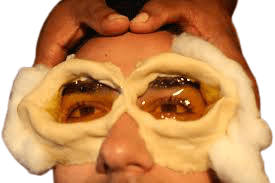Netra tarpana – An eye care in Ayurveda
In this article of netra tarpan ( an ayurvedic eye care process), we will discuss on function of eyes, different diseases of eye, what is Netra tarpan, indication of netra tarpan, drogs used, procedure, time and contraindications and healthy signs of netra tarpana.
Eye is one of the most important and delicate five sense organs in our body. The main functions of the eyes are:
- Perception of colour and the images.
- Vision
- Production of the tears
Eye diseases
Sushruta Samhita, the prime book of surgery in the Ayurveda literature mentions seventy six (76) number of the eye diseases. Out of the 76 eye diseases, 52 are easily curable, 7 can be treated difficultly and 17 are incurable.
According to the involvement of the doshas, the eye diseases can be classified as the following.
Vataja – 10
Pittaja – 10
Kaphaja – 13
Raktaja – 16
Tridoshas – 25
External – 2
Netra tarpana
Kriya kalpa is the set of best therapeutic procedures for every eye diseases. Kriya kalpa consists of 3-7 different procedures for the eye-care according to different texts. Netra tarpana is one of the following procedures.
The word netra means the eyes and tarpana means the nourishment. So, the netra tarpana literally refers to the nourishment of the eyes. It is mentioned that the netra tarpana is the best among all the kriya kalpa procedures for the proper nourishment of the eyes.
Indications of Netra tarpana
- Dejected eyes
- Stiffness of the eyes
- Dry eye
- Roughness of the eyes
- Accidental injury to the eyes
- Squint
- Falling of the eye lashes
- Difficulty in blinking of the eyes
- Scleritis
- Hyperemia
- Black floaters in the vision
- Sub conjunctival haemorrhage
- Conjunctivitis
- Glaucoma
- Ocular pain
- Redness of the eyes
- Epiphora, etc.
Drugs used
There are number of herbs and medicines that can be used for the process of netra tarpana. We use them according to the involvement of doshas and the severity of the condition. These are some of the commonly used medicinal herbs / medicines used in netra tarpana.
- Lukewarm liquid medicines
- Supernatant layer of ghee or medicated ghee
- Gambhaari (Gmelina arborea)
- Jeevanti (Leptadenia reticulate)
- Mishreya (Foeniculum vulgare)
- Haritaki (Terminalia chebula)
- Tuttha (Blue vitriol)
- Yastimadhu (Glycyrrhiza glabra)
- Lodhra (Symplocos racemosa)
- Daruharidra (Berberis aristata)
- Honey
- Milk
Oil is generally not used in netra tarpana, as it has hot potency.
Procedure
- Patient is kept at the place free of excessive sunlight, dust, smoke at a comfortable bed and position.
- Flour of black gram is mixed and grinded with water, made round in structure and kept around both the eyes.
- Then, the medicated liquid is kept upon the eyes, up to the level of covering the eyelashes.
- The medicines are kept for the specific time according to the prakriti (nature) of the patient and disease itself.
- Green leaf is kept over the eyes covering the medicine, so there are no disturbances due to the sunlight.
- After certain time, the leaf is removed up and the liquid is drained out by the help of cotton.
- The round structure of black gram is removed slowly and patient is said to open the eyes slowly.
- Direct bright light should be avoided after opening the eyes.
Time for netra tarpana
The most appropriate time for netra tarpana is the early day or the late day / early evening.
According to the predominance of the doshas, netra tarpana is done accordingly:
Vataja diseases: every day
Pittaja diseases: every second day
Kaphaja diseases: every third day
Healthy individual: every third day
Healthy signs of netra tarpana
- Good tolerance to the light
- Freshness of the eyes
- Feeling of lightness in the eyes
Contraindications
- Cloudy day
- Very hot climate
- Very cold climate
- Physically exerted person
- Vertigo
- Mentally unstable condition
